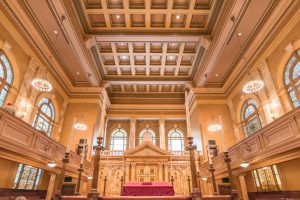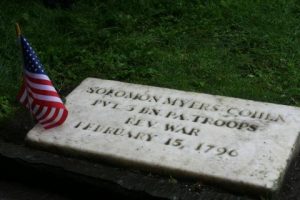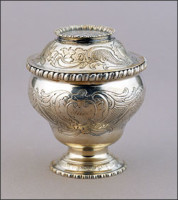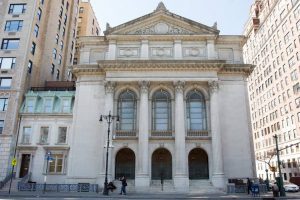NYC’s Spanish & Portuguese Synagogue
(The Central Park West facade of the Spanish and Portuguese Synagogue)
Janet R. Kirchheimer is a writer whose Holocaust-related poetry was praised by Nobel Laureate Elie Wiesel.
She serves as a docent for tours of The Spanish and Portuguese Synagogue — Congregation Shearith Israel — on Central Park West at West 70th Street.
In this interview, I catch up with Janet R. Kirchheimer.
I became interested in being a docent shortly after I joined the synagogue twenty years ago. I was fascinated by the history of the community and wanted to learn more, so becoming a docent was the best way for me to do it. I read books and asked long-time members as many questions as I could.

(A view of the interior of the Spanish and Portuguese Synagogue)
The architect was Arnold Brunner, a Jewish architect who also designed the Cadet Hospital at West Point. The synagogue was consecrated on May 19 1897. Most synagogue designs of that time were Moorish, however the synagogue was designed in Renaissance Greek style.As more and more Jews came into New York, the congregation that had started in the lower part of Manhattan kept moving uptown to accommodate the new members. The first synagogue was built in 1730 and expanded on the same site in 1818 on what is now South William Street. The synagogue moved to Crosby Street in 1834, followed by West 19th street in 1860. In 1897, the congregation moved to Central Park West and 70th Street.
The synagogue also has three historical cemeteries in the city – Chatham Square, 11th Street and 21st Street.

(Chatham Square Cemetery gravestone for Solomon Myers Cohen (1744 – 1796). Cohen fought in the American Revolution to establish the United States of America)
3) What are some of the Colonial-era items that people who tour the synagogue see?
There is an Omer counting board — (used to count down the days between Pesach and Shavuot) — that dates back to the 1600s. Additionally, the “little synagogue” contains a reader’s desk from the first synagogue built in 1730, and seating from the 1834 synagogue, as well as other artifacts used during services dating back to the Colonial Era.

(Congregation Shearith Israel’s historic Omer Board. The letters stand for the Spanish words “Hoy,” today, “Semana,” week, and “Dia,” day).
4) What have been some of the most interesting reactions from people touring The Spanish and Portuguese Synagogue?
A teenager drew me a picture of the sanctuary which I have kept. Many people do not know the history of the synagogue and are excited to learn about many of the influential members, from the famed silversmith Myer Meyers (1723 – 1795) and the Navy Commodore Uriah P. Levy (1792 – 1862) to poet Emma Lazarus (1849 – 1887) and United States Supreme Court Justice Benjamin Cardozo (1870 – 1938). When I tell them that Uriah P. Levy bought Monticello, that always gets a big reaction, as does when I describe the Torahs burned by British soldiers when they occupied New York during the Revolutionary War. The synagogue still retains possession of the charred Torahs.

(A silver sugar bowl made by the Colonial-era Shearith Israel member Myer Myers).
5) Has any of your poetry been inspired by this synagogue?
I haven’t written any poems about the synagogue, but poems have been inspired by it as well as by the dignity and majesty of the sanctuary and the services. And, I am a fan of poet Emma Lazarus, who was a member.
(Ed. — to read Emma Lazarus’s poem “In The Jewish Synagogue at Newport,” go here).
6) Which books or other items in the present-day synagogue reflect its Spanish and Portuguese Jewish past?
The book, Remnant of Israel: A Portrait of America’s First Jewish Congregation by Rabbi Marc D. Angel, Rabbi Emeritus gives a wonderful history of the congregation. Then too, visitors can see portraits of early members lining the hallway, as well as silver made by Myer Myers. In addition, there are two glass cases containing historical information about the congregation.

(Miniature portrait, painted on ivory, of Shearith Israel’s early leader Rev. Gershom Mendes Seixas, who also was one of the incorporators of Columbia University. To learn more about this portrait, go here).
7) What are the most important things for people to learn from taking a tour of The Spanish and Portuguese Synagogue?
The most important thing I stress when giving a tour is that the 23 Jewish refugees from Brazil who arrived in 1654 wanted to be a part of the New Amsterdam, and then later, the New York community. They fought for their rights to stay when Governor Peter Stuyvesant wanted them to leave. They fought to guard the walls in New Amsterdam, to become traders, to build a synagogue and so much more throughout the years. It is the first Jewish community in North America. With a rich history, it has contributed greatly to the American Jewish community.
*****
For information about tours of the Spanish and Portuguese Synagogue, go here.
The following information about poet and docent Janet R. Kirchheimer is taken from an Amazon.com page for her Holocaust-themed poetry collection; “How to Spot one of Us.”
Janet R. Kirchheimer is a poet whose work has appeared in a variety of publications both in the U.S. and abroad. Her moving collection of poems about the Holocaust, How To Spot One Of Us (2007) received endorsements from Nobel Laureate Elie Wiesel, Sir Martin Gilbert, and Rabbis Harold Kushner and Irving Yitz Greenberg (Chairman Emeritus of the U.S. Holocaust Memorial Council), as well as renowned poets Mary Stewart Hammond, Yerra Sugarman, and Jeanne Marie Beaumont, and a selection has been translated into Russian. In 2007, she was nominated for a Pushcart Prize, and in 2010, received a Citation for her work from The Council of The City of New York. Her work has appeared in journals including Atlanta Review, Potomac Review, Limestone, Connecticut Review, Kalliope, Common Ground Review, on beliefnet.com and babelfruit.com, among others. Her essay, Kristallnacht: How Will We Remember? was a special feature in The New York Jewish Week in 2009. A popular speaker, she has appeared on radio programs around the country. As part of a 2009 Multi-National Forces Days of Remembrance Holocaust Memorial Service, she helped design the service, video-taped a reading shown at Camp Victory in Baghdad, Iraq, and judged a poetry contest for soldiers. In 2009, she spoke to over 200 high school students at the Westover School for their annual Holocaust memorial service, and in 2010 spoke to 300 fifth and sixth graders from the Yonkers public school system as part of Holocaust Remembrance Week. A Teaching Fellow at Clal, Janet conducts leadership development seminars, text study and Jewish history classes, as well as workshops in which adults and teens explore their Judaism through creative writing and poetry. She also leads a Poetry Shmooze in which participants read and discuss poems and the art of poetry.
